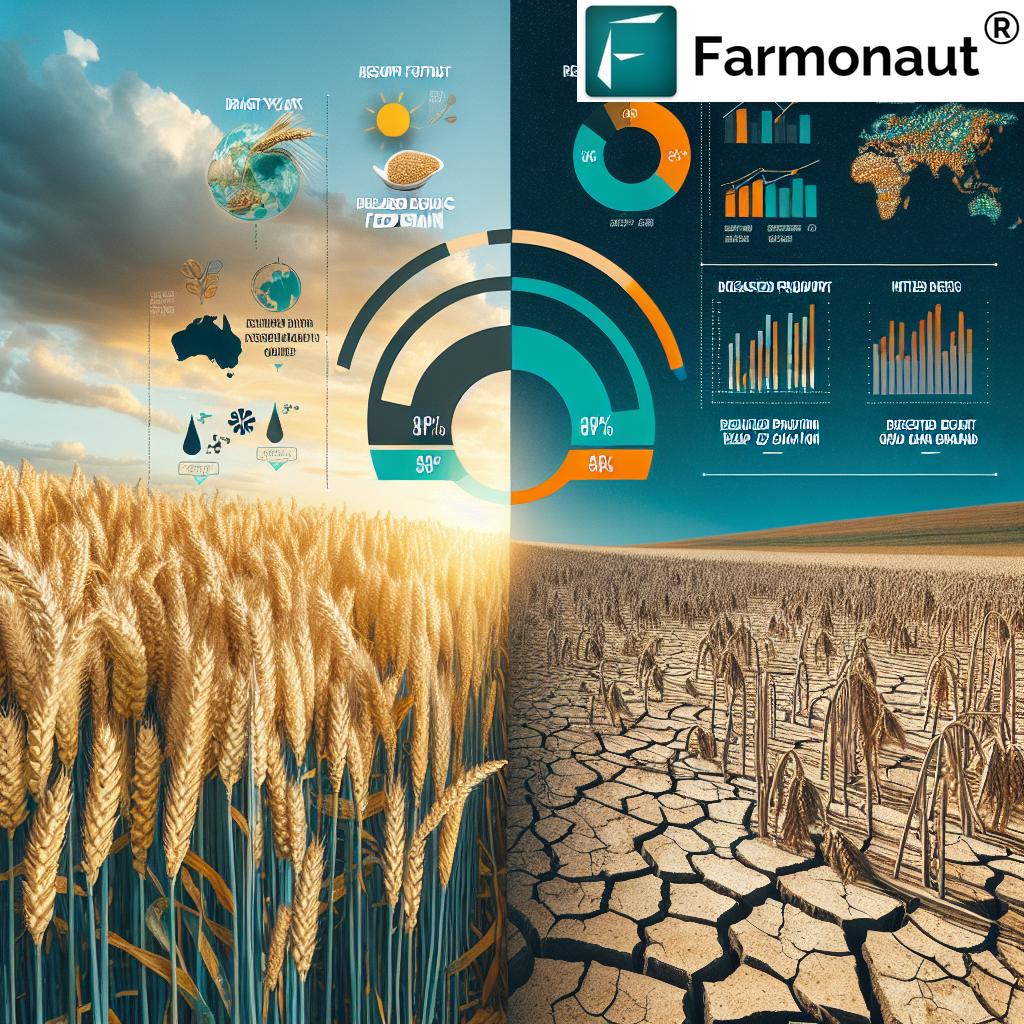Drought Threatens Australian Wheat Crop: Shocking 3.5 Million Tonne Reduction in Production Forecast

CANBERRA, AUSTRALIA — The Australian wheat crop faces significant challenges as persistent dry conditions continue to plague the country’s agricultural landscape. In a recent development that has sent shockwaves through the farming community, the Foreign Agricultural Service (FAS) of the US Department of Agriculture has dramatically reduced its wheat production forecast for Australia by a staggering 3.5 million tonnes.
The Impact of Drought on Australian Wheat Production
The drought impact on agriculture in Australia has been severe, leading to a revised production estimate of 28.5 million tonnes for the 2024-25 crop year. This significant wheat production forecast reduction underscores the vulnerability of the agricultural sector to climatic variations and highlights the urgent need for adaptive strategies.
According to the FAS, the decline from its previous forecast is attributed to a combination of factors:
- Depleted soil moisture
- Insufficient rainfall
- Frost damage in September
These conditions have significantly reduced crop yield potential, painting a concerning picture for Australia’s wheat farmers and the broader agricultural industry.
Resilience Amidst Adversity: A Silver Lining
Despite the challenging circumstances, there’s a glimmer of hope in the latest projections. The FAS’s revised estimate of 28.5 million tonnes, while lower than initially anticipated, still represents a 7% increase above the previous 10-year average of 26.6 million tonnes. Moreover, it’s 10% higher than last year’s output of 25.9 million tonnes, showcasing the Australian agricultural resilience in the face of adverse conditions.

Expanding Wheat Planting Area: A Strategic Response
One of the key factors contributing to the above-average production estimate for 2024-25 is the expansion of the wheat planting area. The FAS reports that the planted area is forecast at 13 million hectares, marking one of the highest figures in the last decade.
Interestingly, this wheat planting area increase is not due to favorable planting conditions. Instead, it’s a strategic response to the challenging environment:
- Poor conditions discouraged canola planting
- Failed canola crops were replanted with wheat in some cases
This adaptive approach by Australian farmers demonstrates their resilience and ability to make crucial decisions in the face of adversity.
Impact on Australian Wheat Exports
The dry conditions affecting the wheat crop have inevitably influenced the Australian wheat export outlook. As a result of the downward revision in production, the FAS has also forecast a slight reduction in agricultural exports from Australia.
Key points regarding wheat exports:
- Exports are projected to drop by 1.2 million tonnes from the July forecast
- The new export estimate stands at 20 million tonnes
- If realized, this would still be slightly above the 10-year average of 19.2 million tonnes
This resilience in export figures, despite the challenging conditions, underscores the importance of wheat in Australia’s agricultural export portfolio.
Domestic Wheat Consumption on the Rise
While the drought impact on agriculture has affected production and exports, domestic wheat consumption in Australia is projected to rise slightly to 8 million tonnes. This increase is primarily attributed to modest growth in feed grain demand, driven by several factors:
- Increasing poultry production
- Rise in cattle numbers
- Growth in beef feedlots
This shift in domestic consumption patterns highlights the complex interplay between various sectors of the agricultural industry and the broader economy.
Technological Solutions for Drought Mitigation
In light of the challenges posed by drought, innovative technological solutions are becoming increasingly crucial for Australian farmers. Farmonaut, a leading agricultural technology company, offers advanced satellite-based crop monitoring and weather forecasting services that can help farmers make informed decisions in the face of unpredictable weather patterns.
Farmers and agricultural professionals can access Farmonaut’s services through various platforms:
- Farmonaut API for integrating satellite data into existing farm management systems
- API Developer Docs for custom implementation of Farmonaut’s technology
- Mobile applications for on-the-go access to crucial agricultural data
Looking Ahead: Challenges and Opportunities
As Australia grapples with the ongoing drought and its impact on the wheat crop, several key considerations come to the forefront:
- Climate Adaptation: The need for drought-resistant wheat varieties and improved water management techniques becomes increasingly urgent.
- Diversification: Farmers may need to consider diversifying their crops to spread risk and enhance resilience against climate variability.
- Technology Adoption: Embracing advanced agricultural technologies, like those offered by Farmonaut, can help farmers better navigate challenging conditions.
- Market Dynamics: The global wheat market may experience shifts due to the reduced Australian output, potentially affecting prices and trade patterns.
- Policy Support: Government initiatives to support farmers during drought periods and encourage sustainable farming practices will be crucial.
Conclusion: Resilience in the Face of Adversity
The Australian wheat drought impact presents significant challenges for the country’s agricultural sector. However, the industry’s ability to maintain above-average production levels despite adverse conditions speaks volumes about its resilience and adaptability.
As Australia continues to navigate these challenging times, the adoption of innovative technologies, sustainable farming practices, and strategic crop management will be key to ensuring the long-term viability and success of its wheat industry. With the right approach and support, Australian agriculture can emerge stronger and more resilient in the face of future climate-related challenges.
Stay informed about the latest developments in Australian agriculture and access cutting-edge crop monitoring tools with Farmonaut. Together, we can build a more resilient and sustainable future for Australian wheat production.
















